Paramedical Services Assignment: Pharmacology, Scenarios, BLS and More
VerifiedAdded on 2023/04/19
|24
|5259
|123
Homework Assignment
AI Summary
This assignment covers various aspects of paramedical services, including pharmacology, practice scenarios, and basic life support. The pharmacology section details adverse effects, indications, contraindications, and dosages of medications such as oxygen, acetylsalicylic acid, Entonox, Methoxyflurane, and Paracetamol, along with actions of adrenaline. It includes information on automated external defibrillation and advanced resuscitation techniques, defining terms like hypoxia, ventilation, and internal/external respiration. The assignment presents three practice scenarios focusing on assessment and treatment for asthma, accidents (back pain), and substantial pain in a child, outlining assessment methods and treatment plans using API. The assignment also includes anatomical positions and their clinical significance.
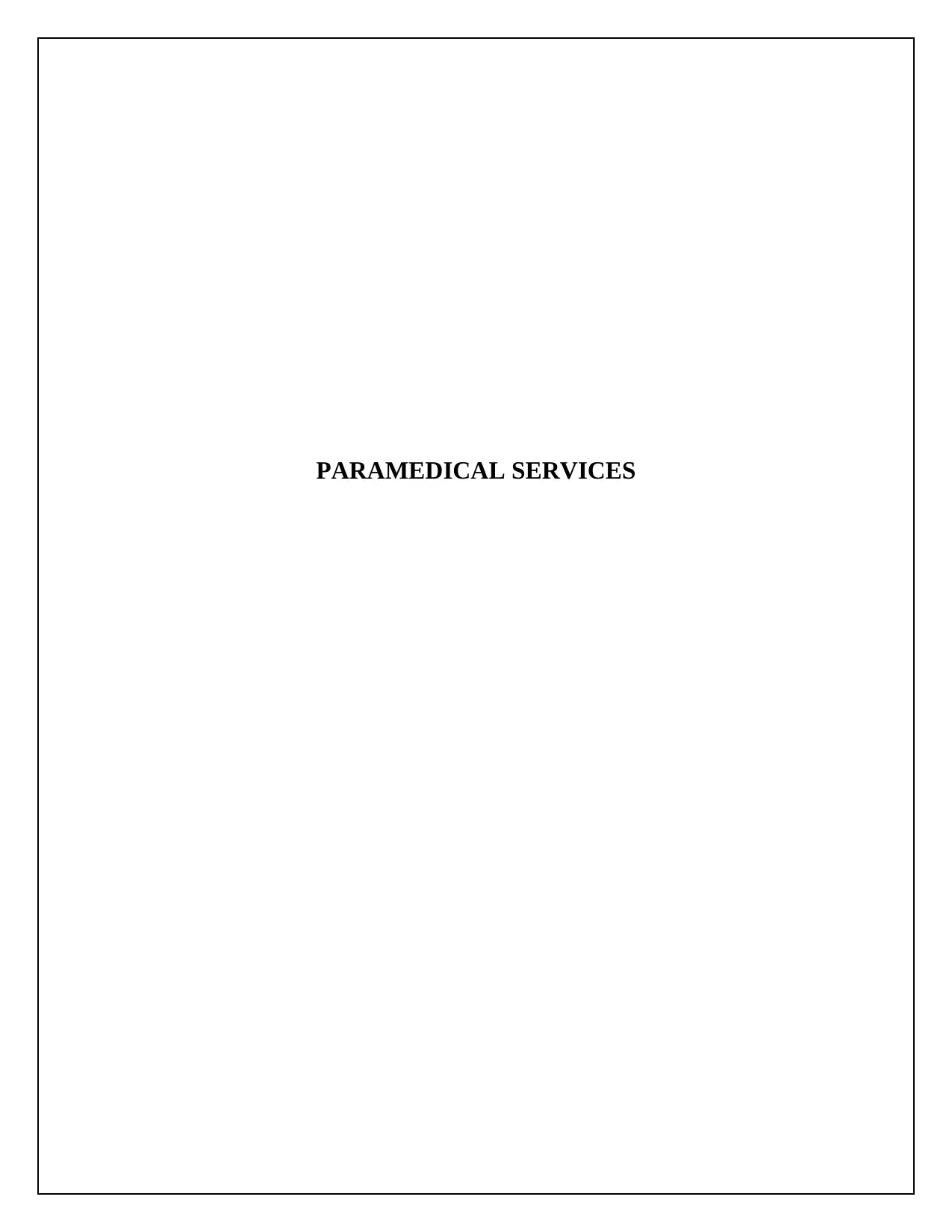
PARAMEDICAL SERVICES
Paraphrase This Document
Need a fresh take? Get an instant paraphrase of this document with our AI Paraphraser

Table of Contents
Pharmacology..................................................................................................................................4
Practice scenarios...........................................................................................................................11
Scenario writing.............................................................................................................................12
Basic life support...........................................................................................................................13
Posture...........................................................................................................................................17
Patient Management......................................................................................................................18
Reference list.................................................................................................................................21
2
Pharmacology..................................................................................................................................4
Practice scenarios...........................................................................................................................11
Scenario writing.............................................................................................................................12
Basic life support...........................................................................................................................13
Posture...........................................................................................................................................17
Patient Management......................................................................................................................18
Reference list.................................................................................................................................21
2
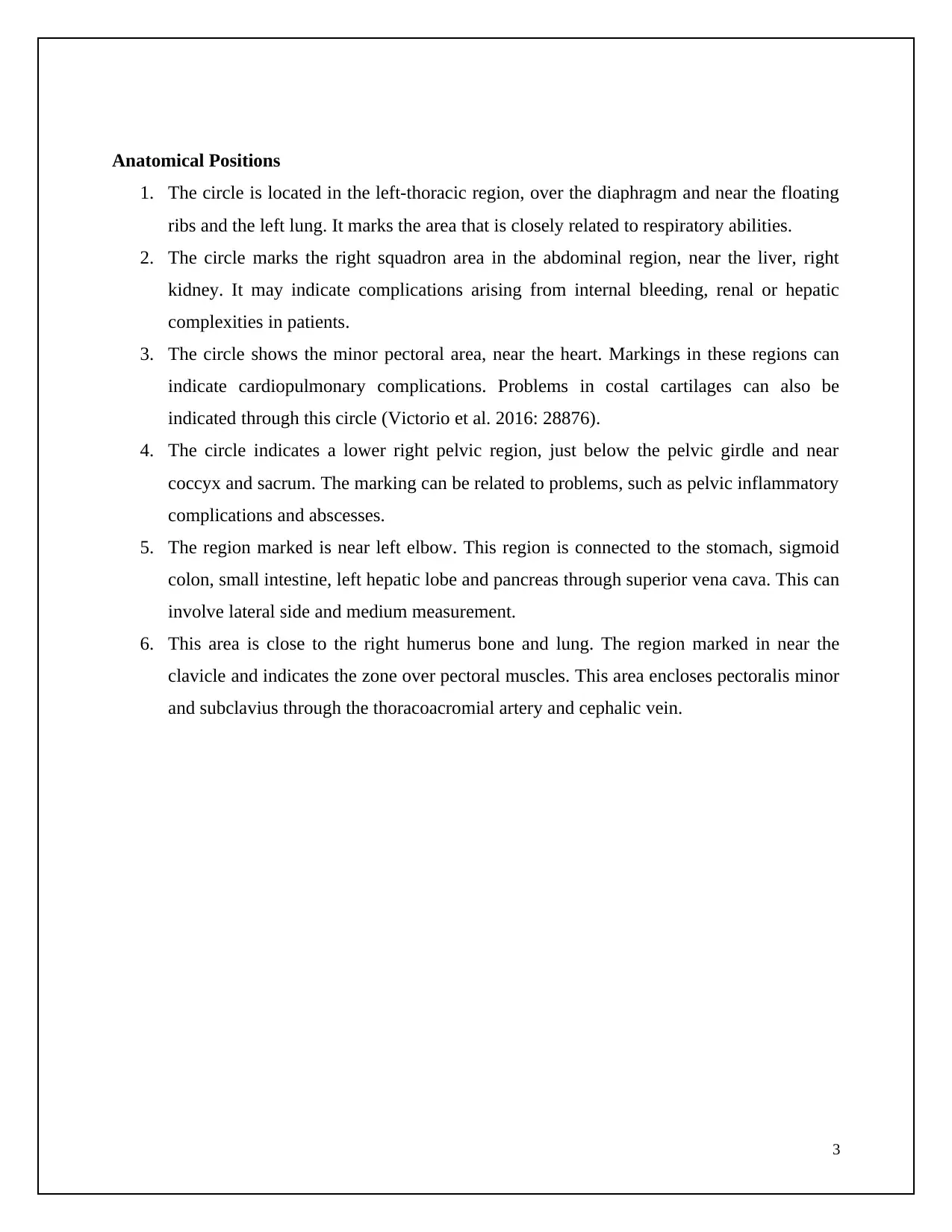
Anatomical Positions
1. The circle is located in the left-thoracic region, over the diaphragm and near the floating
ribs and the left lung. It marks the area that is closely related to respiratory abilities.
2. The circle marks the right squadron area in the abdominal region, near the liver, right
kidney. It may indicate complications arising from internal bleeding, renal or hepatic
complexities in patients.
3. The circle shows the minor pectoral area, near the heart. Markings in these regions can
indicate cardiopulmonary complications. Problems in costal cartilages can also be
indicated through this circle (Victorio et al. 2016: 28876).
4. The circle indicates a lower right pelvic region, just below the pelvic girdle and near
coccyx and sacrum. The marking can be related to problems, such as pelvic inflammatory
complications and abscesses.
5. The region marked is near left elbow. This region is connected to the stomach, sigmoid
colon, small intestine, left hepatic lobe and pancreas through superior vena cava. This can
involve lateral side and medium measurement.
6. This area is close to the right humerus bone and lung. The region marked in near the
clavicle and indicates the zone over pectoral muscles. This area encloses pectoralis minor
and subclavius through the thoracoacromial artery and cephalic vein.
3
1. The circle is located in the left-thoracic region, over the diaphragm and near the floating
ribs and the left lung. It marks the area that is closely related to respiratory abilities.
2. The circle marks the right squadron area in the abdominal region, near the liver, right
kidney. It may indicate complications arising from internal bleeding, renal or hepatic
complexities in patients.
3. The circle shows the minor pectoral area, near the heart. Markings in these regions can
indicate cardiopulmonary complications. Problems in costal cartilages can also be
indicated through this circle (Victorio et al. 2016: 28876).
4. The circle indicates a lower right pelvic region, just below the pelvic girdle and near
coccyx and sacrum. The marking can be related to problems, such as pelvic inflammatory
complications and abscesses.
5. The region marked is near left elbow. This region is connected to the stomach, sigmoid
colon, small intestine, left hepatic lobe and pancreas through superior vena cava. This can
involve lateral side and medium measurement.
6. This area is close to the right humerus bone and lung. The region marked in near the
clavicle and indicates the zone over pectoral muscles. This area encloses pectoralis minor
and subclavius through the thoracoacromial artery and cephalic vein.
3
⊘ This is a preview!⊘
Do you want full access?
Subscribe today to unlock all pages.

Trusted by 1+ million students worldwide
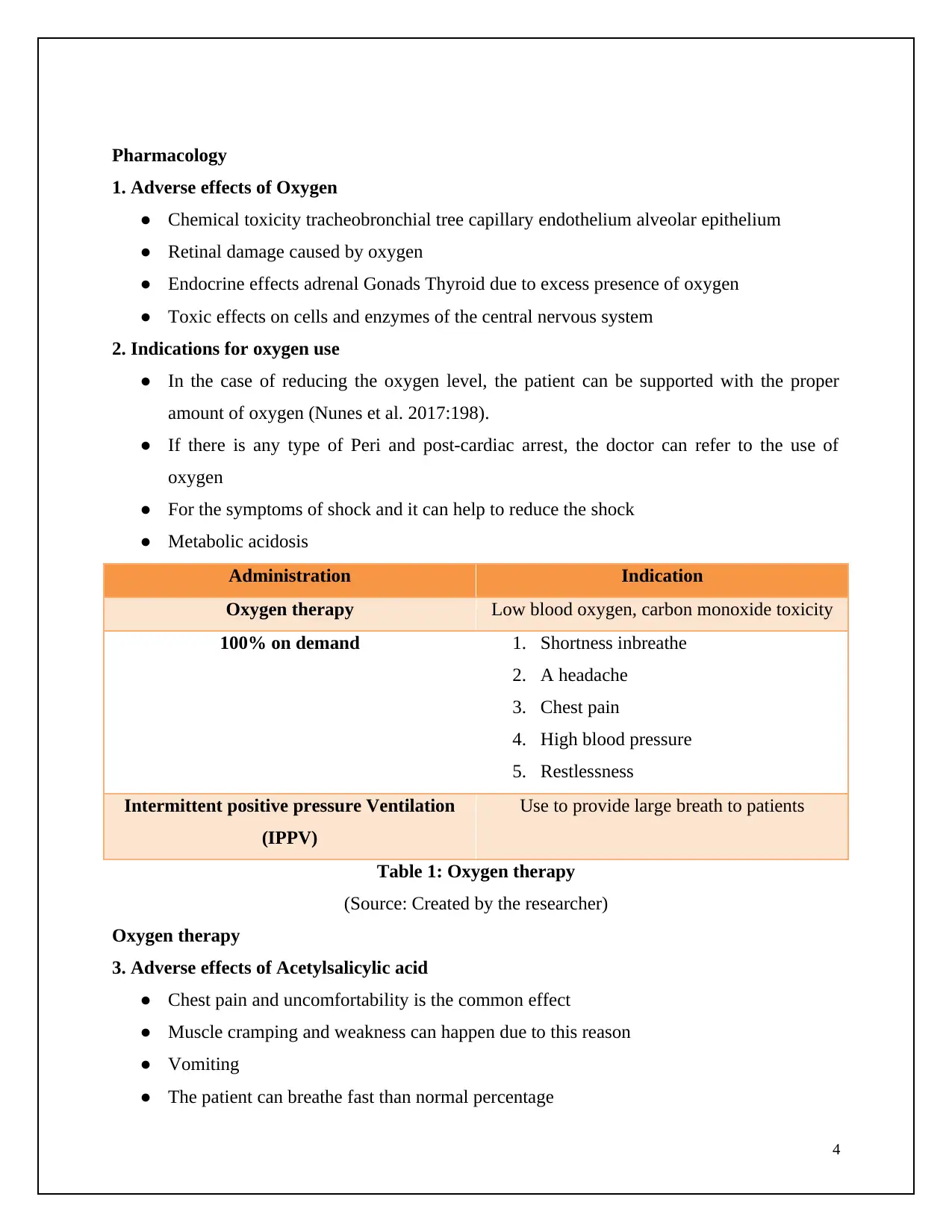
Pharmacology
1. Adverse effects of Oxygen
● Chemical toxicity tracheobronchial tree capillary endothelium alveolar epithelium
● Retinal damage caused by oxygen
● Endocrine effects adrenal Gonads Thyroid due to excess presence of oxygen
● Toxic effects on cells and enzymes of the central nervous system
2. Indications for oxygen use
● In the case of reducing the oxygen level, the patient can be supported with the proper
amount of oxygen (Nunes et al. 2017:198).
● If there is any type of Peri and post-cardiac arrest, the doctor can refer to the use of
oxygen
● For the symptoms of shock and it can help to reduce the shock
● Metabolic acidosis
Administration Indication
Oxygen therapy Low blood oxygen, carbon monoxide toxicity
100% on demand 1. Shortness inbreathe
2. A headache
3. Chest pain
4. High blood pressure
5. Restlessness
Intermittent positive pressure Ventilation
(IPPV)
Use to provide large breath to patients
Table 1: Oxygen therapy
(Source: Created by the researcher)
Oxygen therapy
3. Adverse effects of Acetylsalicylic acid
● Chest pain and uncomfortability is the common effect
● Muscle cramping and weakness can happen due to this reason
● Vomiting
● The patient can breathe fast than normal percentage
4
1. Adverse effects of Oxygen
● Chemical toxicity tracheobronchial tree capillary endothelium alveolar epithelium
● Retinal damage caused by oxygen
● Endocrine effects adrenal Gonads Thyroid due to excess presence of oxygen
● Toxic effects on cells and enzymes of the central nervous system
2. Indications for oxygen use
● In the case of reducing the oxygen level, the patient can be supported with the proper
amount of oxygen (Nunes et al. 2017:198).
● If there is any type of Peri and post-cardiac arrest, the doctor can refer to the use of
oxygen
● For the symptoms of shock and it can help to reduce the shock
● Metabolic acidosis
Administration Indication
Oxygen therapy Low blood oxygen, carbon monoxide toxicity
100% on demand 1. Shortness inbreathe
2. A headache
3. Chest pain
4. High blood pressure
5. Restlessness
Intermittent positive pressure Ventilation
(IPPV)
Use to provide large breath to patients
Table 1: Oxygen therapy
(Source: Created by the researcher)
Oxygen therapy
3. Adverse effects of Acetylsalicylic acid
● Chest pain and uncomfortability is the common effect
● Muscle cramping and weakness can happen due to this reason
● Vomiting
● The patient can breathe fast than normal percentage
4
Paraphrase This Document
Need a fresh take? Get an instant paraphrase of this document with our AI Paraphraser

4. Contraindications of Acetylsalicylic acid
● Varicella
● Deficiency of G6PD
● Aspirin triad
● GI bleeding
5. The adult dose of Acetylsalicylic acid
● Pain /fever - 325-650 mg
● MI prevention- 81-325mg
● Coronary syndrome- 162-325mg
6. Adverse effects of Entonox
● Nausea
● Dry mouth
● Dizziness
● Tingling fingers
● Dysphoria
7. Contraindications of Entonox
The seven contraindications of Entonox are:
● Hypersensitivity
● Renal impairment
● Peptic Ulceration
● Changed mental status
● Facial trauma
● Respiratory problems
● Using of drug or intoxication
8. Adverse effects of Methoxyflurane
● Damage of kidney due to excess amount of Methoxyflurane
● Delirium
● The patient can feel drowsiness
● There is a Throwing up feeling inside the body of the patient
7. Contraindications of Methoxyflurane
● The issue in the liver and kidney functioning reduced
5
● Varicella
● Deficiency of G6PD
● Aspirin triad
● GI bleeding
5. The adult dose of Acetylsalicylic acid
● Pain /fever - 325-650 mg
● MI prevention- 81-325mg
● Coronary syndrome- 162-325mg
6. Adverse effects of Entonox
● Nausea
● Dry mouth
● Dizziness
● Tingling fingers
● Dysphoria
7. Contraindications of Entonox
The seven contraindications of Entonox are:
● Hypersensitivity
● Renal impairment
● Peptic Ulceration
● Changed mental status
● Facial trauma
● Respiratory problems
● Using of drug or intoxication
8. Adverse effects of Methoxyflurane
● Damage of kidney due to excess amount of Methoxyflurane
● Delirium
● The patient can feel drowsiness
● There is a Throwing up feeling inside the body of the patient
7. Contraindications of Methoxyflurane
● The issue in the liver and kidney functioning reduced
5
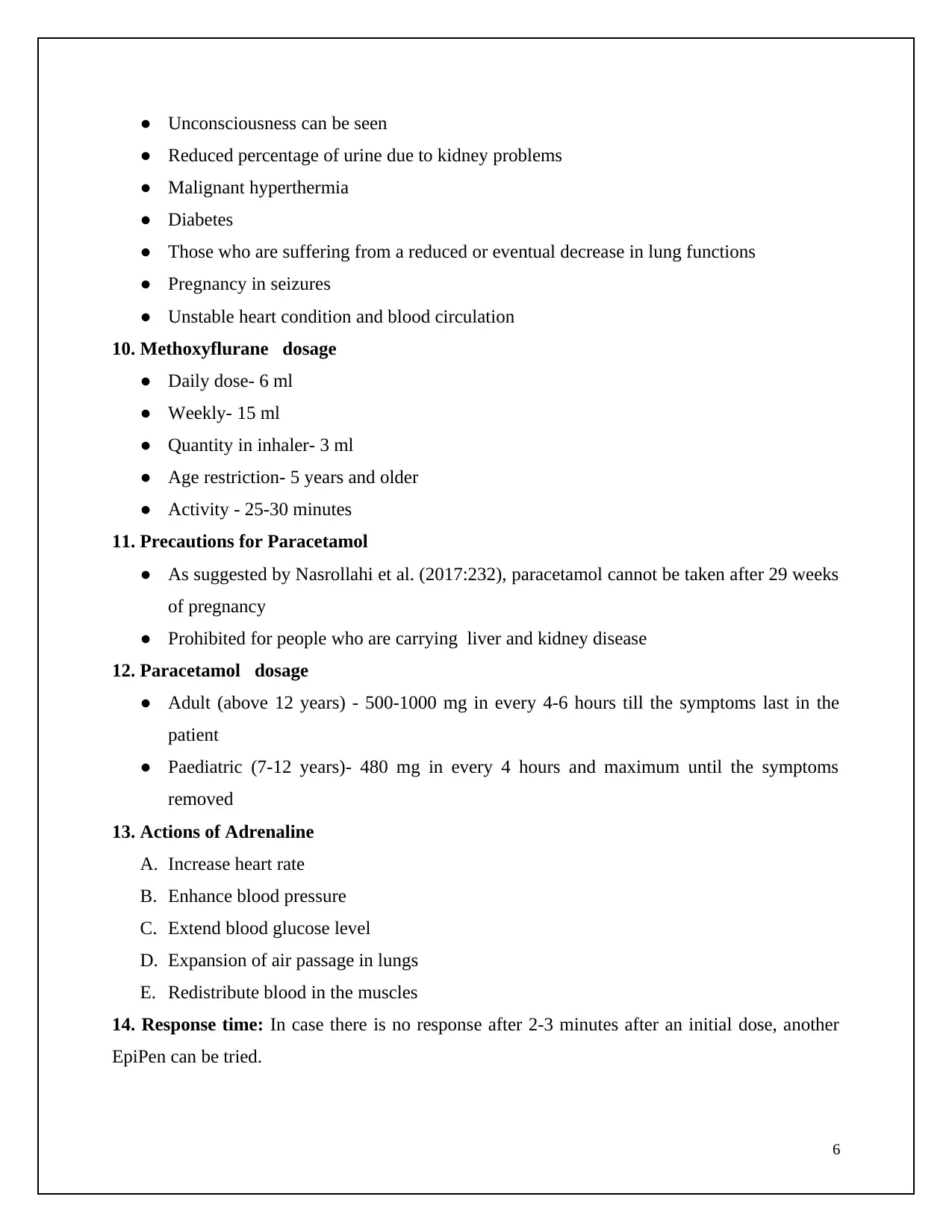
● Unconsciousness can be seen
● Reduced percentage of urine due to kidney problems
● Malignant hyperthermia
● Diabetes
● Those who are suffering from a reduced or eventual decrease in lung functions
● Pregnancy in seizures
● Unstable heart condition and blood circulation
10. Methoxyflurane dosage
● Daily dose- 6 ml
● Weekly- 15 ml
● Quantity in inhaler- 3 ml
● Age restriction- 5 years and older
● Activity - 25-30 minutes
11. Precautions for Paracetamol
● As suggested by Nasrollahi et al. (2017:232), paracetamol cannot be taken after 29 weeks
of pregnancy
● Prohibited for people who are carrying liver and kidney disease
12. Paracetamol dosage
● Adult (above 12 years) - 500-1000 mg in every 4-6 hours till the symptoms last in the
patient
● Paediatric (7-12 years)- 480 mg in every 4 hours and maximum until the symptoms
removed
13. Actions of Adrenaline
A. Increase heart rate
B. Enhance blood pressure
C. Extend blood glucose level
D. Expansion of air passage in lungs
E. Redistribute blood in the muscles
14. Response time: In case there is no response after 2-3 minutes after an initial dose, another
EpiPen can be tried.
6
● Reduced percentage of urine due to kidney problems
● Malignant hyperthermia
● Diabetes
● Those who are suffering from a reduced or eventual decrease in lung functions
● Pregnancy in seizures
● Unstable heart condition and blood circulation
10. Methoxyflurane dosage
● Daily dose- 6 ml
● Weekly- 15 ml
● Quantity in inhaler- 3 ml
● Age restriction- 5 years and older
● Activity - 25-30 minutes
11. Precautions for Paracetamol
● As suggested by Nasrollahi et al. (2017:232), paracetamol cannot be taken after 29 weeks
of pregnancy
● Prohibited for people who are carrying liver and kidney disease
12. Paracetamol dosage
● Adult (above 12 years) - 500-1000 mg in every 4-6 hours till the symptoms last in the
patient
● Paediatric (7-12 years)- 480 mg in every 4 hours and maximum until the symptoms
removed
13. Actions of Adrenaline
A. Increase heart rate
B. Enhance blood pressure
C. Extend blood glucose level
D. Expansion of air passage in lungs
E. Redistribute blood in the muscles
14. Response time: In case there is no response after 2-3 minutes after an initial dose, another
EpiPen can be tried.
6
⊘ This is a preview!⊘
Do you want full access?
Subscribe today to unlock all pages.

Trusted by 1+ million students worldwide
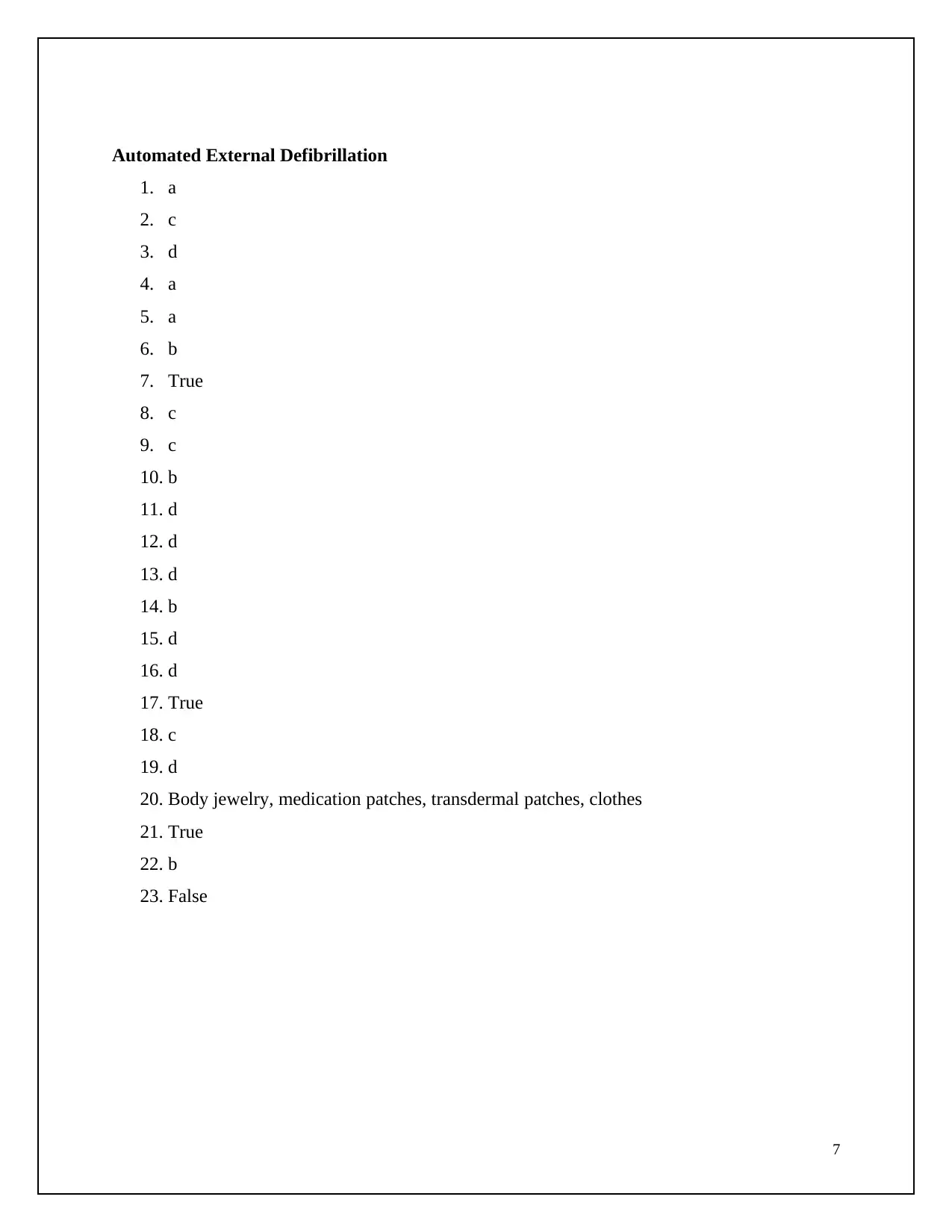
Automated External Defibrillation
1. a
2. c
3. d
4. a
5. a
6. b
7. True
8. c
9. c
10. b
11. d
12. d
13. d
14. b
15. d
16. d
17. True
18. c
19. d
20. Body jewelry, medication patches, transdermal patches, clothes
21. True
22. b
23. False
7
1. a
2. c
3. d
4. a
5. a
6. b
7. True
8. c
9. c
10. b
11. d
12. d
13. d
14. b
15. d
16. d
17. True
18. c
19. d
20. Body jewelry, medication patches, transdermal patches, clothes
21. True
22. b
23. False
7
Paraphrase This Document
Need a fresh take? Get an instant paraphrase of this document with our AI Paraphraser

Advanced Resuscitation
1.
a. Hypoxic
b. Slow
c. Five indications for 100% on demand
i. Alveolar hypoventilation due to neuromuscular disorders or drug overdose
ii. Ventilation-perfusion mismatch between atelectatic and pneumonic lung
zones
iii. Tissue hypoxia with myocardial infarction
iv. Hypovolemic shock
v. Carbon monoxide poisoning
d. Two indications for IPPV
i. Apnea with intermittent respiratory arrest or bradypnea
ii. Tachypnea with the respiratory rate more than 30 breaths each minute
2. Hazards or adverse effects of oxygen use
a. Infection from tube slipping can cause injury to trachea and mucus blocks.
b. Epidermal irritation or bloody nose during oxygen administration
c. Headaches, fatigue or general malaise
3. Colour of a medical oxygen cylinder is white
4. Oxygen delivery mechanism
a. Devices
i. Oxygen connectors and tubing (for O2 therapy)
ii. Humidified, heated and high-flow oxygen nasal cannula (for 100% on
Demand)
b. Oxygen delivery
i. Resuscitation (delivery)
ii. Hyper-inflation systems (devices)
5. True
6. a
7. d
8
1.
a. Hypoxic
b. Slow
c. Five indications for 100% on demand
i. Alveolar hypoventilation due to neuromuscular disorders or drug overdose
ii. Ventilation-perfusion mismatch between atelectatic and pneumonic lung
zones
iii. Tissue hypoxia with myocardial infarction
iv. Hypovolemic shock
v. Carbon monoxide poisoning
d. Two indications for IPPV
i. Apnea with intermittent respiratory arrest or bradypnea
ii. Tachypnea with the respiratory rate more than 30 breaths each minute
2. Hazards or adverse effects of oxygen use
a. Infection from tube slipping can cause injury to trachea and mucus blocks.
b. Epidermal irritation or bloody nose during oxygen administration
c. Headaches, fatigue or general malaise
3. Colour of a medical oxygen cylinder is white
4. Oxygen delivery mechanism
a. Devices
i. Oxygen connectors and tubing (for O2 therapy)
ii. Humidified, heated and high-flow oxygen nasal cannula (for 100% on
Demand)
b. Oxygen delivery
i. Resuscitation (delivery)
ii. Hyper-inflation systems (devices)
5. True
6. a
7. d
8
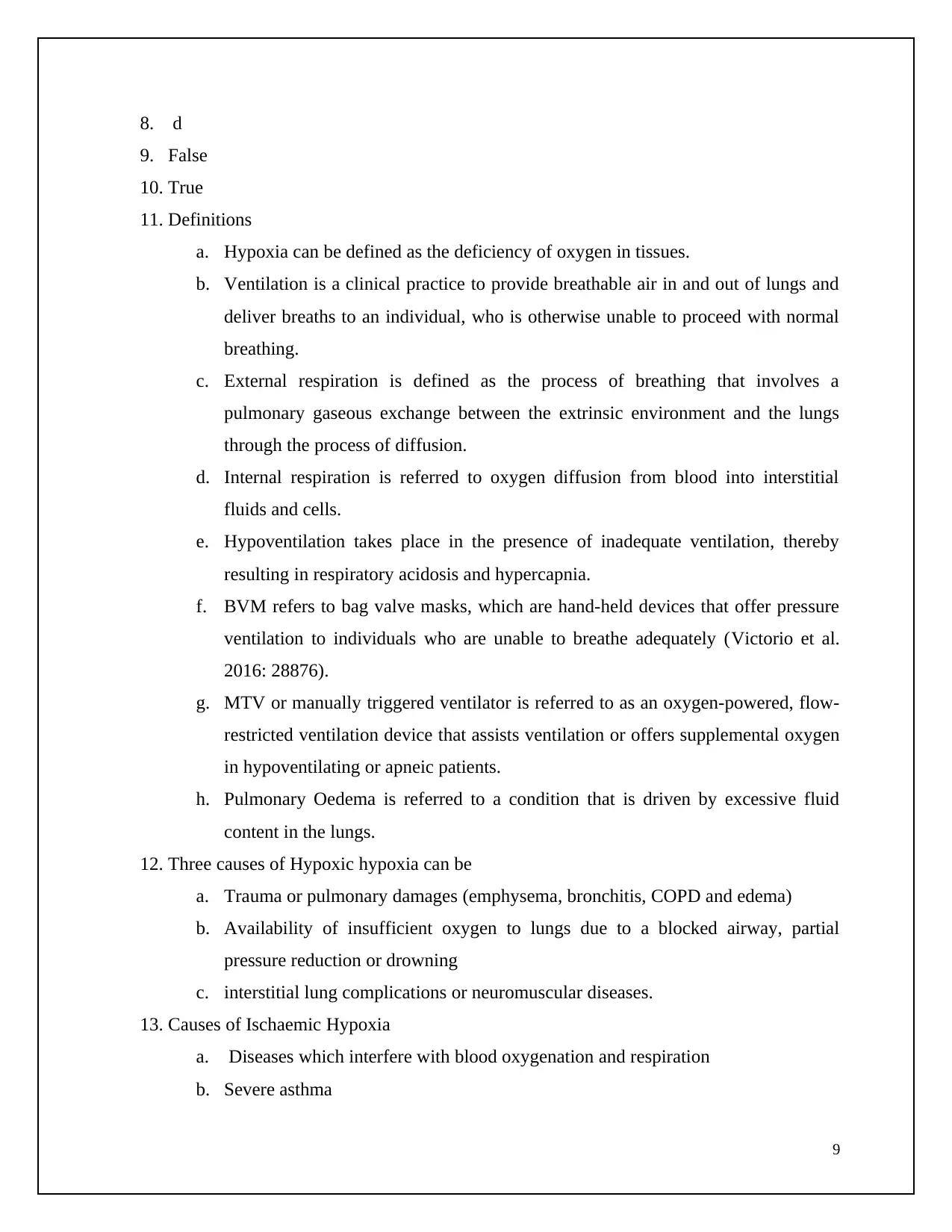
8. d
9. False
10. True
11. Definitions
a. Hypoxia can be defined as the deficiency of oxygen in tissues.
b. Ventilation is a clinical practice to provide breathable air in and out of lungs and
deliver breaths to an individual, who is otherwise unable to proceed with normal
breathing.
c. External respiration is defined as the process of breathing that involves a
pulmonary gaseous exchange between the extrinsic environment and the lungs
through the process of diffusion.
d. Internal respiration is referred to oxygen diffusion from blood into interstitial
fluids and cells.
e. Hypoventilation takes place in the presence of inadequate ventilation, thereby
resulting in respiratory acidosis and hypercapnia.
f. BVM refers to bag valve masks, which are hand-held devices that offer pressure
ventilation to individuals who are unable to breathe adequately (Victorio et al.
2016: 28876).
g. MTV or manually triggered ventilator is referred to as an oxygen-powered, flow-
restricted ventilation device that assists ventilation or offers supplemental oxygen
in hypoventilating or apneic patients.
h. Pulmonary Oedema is referred to a condition that is driven by excessive fluid
content in the lungs.
12. Three causes of Hypoxic hypoxia can be
a. Trauma or pulmonary damages (emphysema, bronchitis, COPD and edema)
b. Availability of insufficient oxygen to lungs due to a blocked airway, partial
pressure reduction or drowning
c. interstitial lung complications or neuromuscular diseases.
13. Causes of Ischaemic Hypoxia
a. Diseases which interfere with blood oxygenation and respiration
b. Severe asthma
9
9. False
10. True
11. Definitions
a. Hypoxia can be defined as the deficiency of oxygen in tissues.
b. Ventilation is a clinical practice to provide breathable air in and out of lungs and
deliver breaths to an individual, who is otherwise unable to proceed with normal
breathing.
c. External respiration is defined as the process of breathing that involves a
pulmonary gaseous exchange between the extrinsic environment and the lungs
through the process of diffusion.
d. Internal respiration is referred to oxygen diffusion from blood into interstitial
fluids and cells.
e. Hypoventilation takes place in the presence of inadequate ventilation, thereby
resulting in respiratory acidosis and hypercapnia.
f. BVM refers to bag valve masks, which are hand-held devices that offer pressure
ventilation to individuals who are unable to breathe adequately (Victorio et al.
2016: 28876).
g. MTV or manually triggered ventilator is referred to as an oxygen-powered, flow-
restricted ventilation device that assists ventilation or offers supplemental oxygen
in hypoventilating or apneic patients.
h. Pulmonary Oedema is referred to a condition that is driven by excessive fluid
content in the lungs.
12. Three causes of Hypoxic hypoxia can be
a. Trauma or pulmonary damages (emphysema, bronchitis, COPD and edema)
b. Availability of insufficient oxygen to lungs due to a blocked airway, partial
pressure reduction or drowning
c. interstitial lung complications or neuromuscular diseases.
13. Causes of Ischaemic Hypoxia
a. Diseases which interfere with blood oxygenation and respiration
b. Severe asthma
9
⊘ This is a preview!⊘
Do you want full access?
Subscribe today to unlock all pages.

Trusted by 1+ million students worldwide

c. Working in nitrogen-rich ambiances.
14. Anemic hypoxia is caused by decreased tissue perfusion, iron deficiency, and
downregulated erythropoietin.
15. The main cause can be disabled oxidative phosphorylation enzymes. Furthermore, agents
that decrease cellular respiration are responsible for histotoxic hypoxia (Stetzik et al.
2015: 107). These agents can be cyanide, formaldehyde, narcotics, acetone, alcohol or
anesthetic compounds.
16. Four common signs and symptoms of hypoxia are given below
a. changes in skin color (blue to red)
b. Confusion
c. wheezing
d. irregular heart rate
17. Complications during fluid removal from patients' airways can involve, blocked cannula
from mucous plugging, tracheostomal bleeding or cellulitis, pneumothorax, subcutaneous
emphysema or pneumo-mediastinum, granulation tissue or tracheo-oesophageal fistulas.
18. The primary indication for utilization of oropharyngeal airway is impending risk of
airway obstruction for the patient due to relaxations or blockage of upper airway muscles
by the tongue (Maleh et al. 2016: 99). It can also be used to open or maintain a blocked
airway of a patient.
19. Complications of oropharyngeal airways
a. Induction of vomiting that can lead to aspiration.
b. It can worsen or cause airway obstruction in case an ineffective sized airway is
utilized.
c. Inappropriately sized tracheal pathway can give rise to laryngospasm.
d. Damage to dentition or oral structures can result from oropharyngeal insertion can
take place (Horsting et al. 2015: 65).
e. Soft tissue damage can happen to the pharynx, tongue, and palate.
10
14. Anemic hypoxia is caused by decreased tissue perfusion, iron deficiency, and
downregulated erythropoietin.
15. The main cause can be disabled oxidative phosphorylation enzymes. Furthermore, agents
that decrease cellular respiration are responsible for histotoxic hypoxia (Stetzik et al.
2015: 107). These agents can be cyanide, formaldehyde, narcotics, acetone, alcohol or
anesthetic compounds.
16. Four common signs and symptoms of hypoxia are given below
a. changes in skin color (blue to red)
b. Confusion
c. wheezing
d. irregular heart rate
17. Complications during fluid removal from patients' airways can involve, blocked cannula
from mucous plugging, tracheostomal bleeding or cellulitis, pneumothorax, subcutaneous
emphysema or pneumo-mediastinum, granulation tissue or tracheo-oesophageal fistulas.
18. The primary indication for utilization of oropharyngeal airway is impending risk of
airway obstruction for the patient due to relaxations or blockage of upper airway muscles
by the tongue (Maleh et al. 2016: 99). It can also be used to open or maintain a blocked
airway of a patient.
19. Complications of oropharyngeal airways
a. Induction of vomiting that can lead to aspiration.
b. It can worsen or cause airway obstruction in case an ineffective sized airway is
utilized.
c. Inappropriately sized tracheal pathway can give rise to laryngospasm.
d. Damage to dentition or oral structures can result from oropharyngeal insertion can
take place (Horsting et al. 2015: 65).
e. Soft tissue damage can happen to the pharynx, tongue, and palate.
10
Paraphrase This Document
Need a fresh take? Get an instant paraphrase of this document with our AI Paraphraser
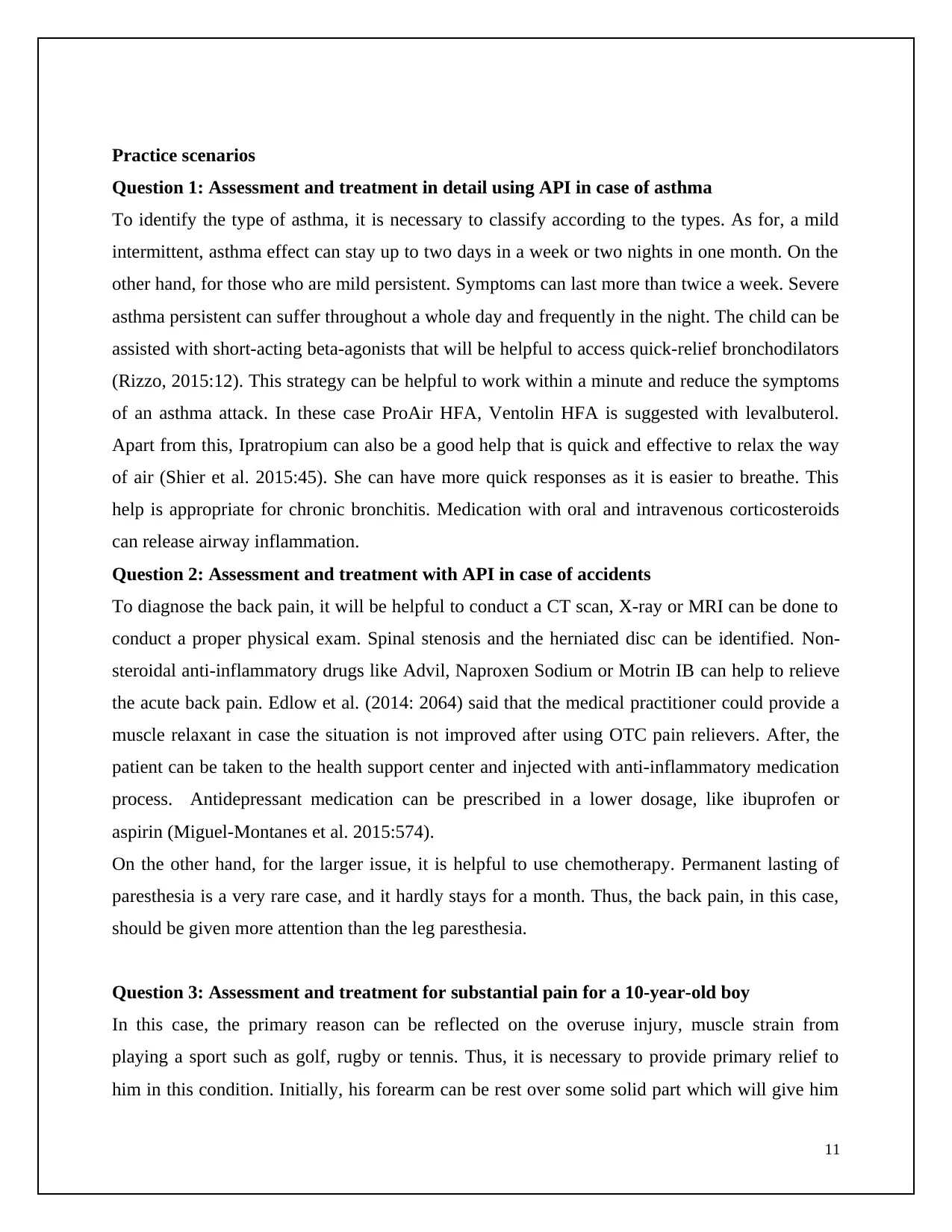
Practice scenarios
Question 1: Assessment and treatment in detail using API in case of asthma
To identify the type of asthma, it is necessary to classify according to the types. As for, a mild
intermittent, asthma effect can stay up to two days in a week or two nights in one month. On the
other hand, for those who are mild persistent. Symptoms can last more than twice a week. Severe
asthma persistent can suffer throughout a whole day and frequently in the night. The child can be
assisted with short-acting beta-agonists that will be helpful to access quick-relief bronchodilators
(Rizzo, 2015:12). This strategy can be helpful to work within a minute and reduce the symptoms
of an asthma attack. In these case ProAir HFA, Ventolin HFA is suggested with levalbuterol.
Apart from this, Ipratropium can also be a good help that is quick and effective to relax the way
of air (Shier et al. 2015:45). She can have more quick responses as it is easier to breathe. This
help is appropriate for chronic bronchitis. Medication with oral and intravenous corticosteroids
can release airway inflammation.
Question 2: Assessment and treatment with API in case of accidents
To diagnose the back pain, it will be helpful to conduct a CT scan, X-ray or MRI can be done to
conduct a proper physical exam. Spinal stenosis and the herniated disc can be identified. Non-
steroidal anti-inflammatory drugs like Advil, Naproxen Sodium or Motrin IB can help to relieve
the acute back pain. Edlow et al. (2014: 2064) said that the medical practitioner could provide a
muscle relaxant in case the situation is not improved after using OTC pain relievers. After, the
patient can be taken to the health support center and injected with anti-inflammatory medication
process. Antidepressant medication can be prescribed in a lower dosage, like ibuprofen or
aspirin (Miguel-Montanes et al. 2015:574).
On the other hand, for the larger issue, it is helpful to use chemotherapy. Permanent lasting of
paresthesia is a very rare case, and it hardly stays for a month. Thus, the back pain, in this case,
should be given more attention than the leg paresthesia.
Question 3: Assessment and treatment for substantial pain for a 10-year-old boy
In this case, the primary reason can be reflected on the overuse injury, muscle strain from
playing a sport such as golf, rugby or tennis. Thus, it is necessary to provide primary relief to
him in this condition. Initially, his forearm can be rest over some solid part which will give him
11
Question 1: Assessment and treatment in detail using API in case of asthma
To identify the type of asthma, it is necessary to classify according to the types. As for, a mild
intermittent, asthma effect can stay up to two days in a week or two nights in one month. On the
other hand, for those who are mild persistent. Symptoms can last more than twice a week. Severe
asthma persistent can suffer throughout a whole day and frequently in the night. The child can be
assisted with short-acting beta-agonists that will be helpful to access quick-relief bronchodilators
(Rizzo, 2015:12). This strategy can be helpful to work within a minute and reduce the symptoms
of an asthma attack. In these case ProAir HFA, Ventolin HFA is suggested with levalbuterol.
Apart from this, Ipratropium can also be a good help that is quick and effective to relax the way
of air (Shier et al. 2015:45). She can have more quick responses as it is easier to breathe. This
help is appropriate for chronic bronchitis. Medication with oral and intravenous corticosteroids
can release airway inflammation.
Question 2: Assessment and treatment with API in case of accidents
To diagnose the back pain, it will be helpful to conduct a CT scan, X-ray or MRI can be done to
conduct a proper physical exam. Spinal stenosis and the herniated disc can be identified. Non-
steroidal anti-inflammatory drugs like Advil, Naproxen Sodium or Motrin IB can help to relieve
the acute back pain. Edlow et al. (2014: 2064) said that the medical practitioner could provide a
muscle relaxant in case the situation is not improved after using OTC pain relievers. After, the
patient can be taken to the health support center and injected with anti-inflammatory medication
process. Antidepressant medication can be prescribed in a lower dosage, like ibuprofen or
aspirin (Miguel-Montanes et al. 2015:574).
On the other hand, for the larger issue, it is helpful to use chemotherapy. Permanent lasting of
paresthesia is a very rare case, and it hardly stays for a month. Thus, the back pain, in this case,
should be given more attention than the leg paresthesia.
Question 3: Assessment and treatment for substantial pain for a 10-year-old boy
In this case, the primary reason can be reflected on the overuse injury, muscle strain from
playing a sport such as golf, rugby or tennis. Thus, it is necessary to provide primary relief to
him in this condition. Initially, his forearm can be rest over some solid part which will give him
11
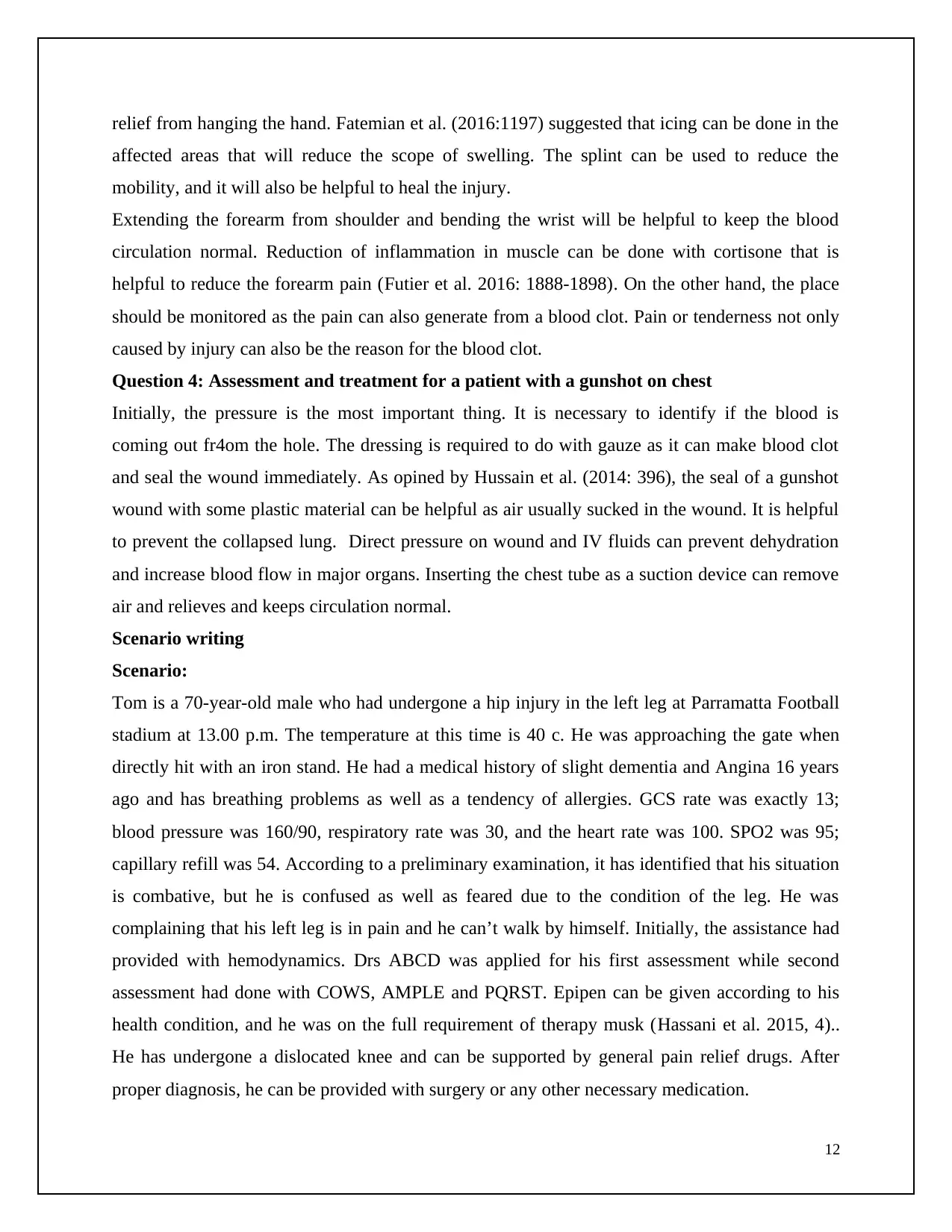
relief from hanging the hand. Fatemian et al. (2016:1197) suggested that icing can be done in the
affected areas that will reduce the scope of swelling. The splint can be used to reduce the
mobility, and it will also be helpful to heal the injury.
Extending the forearm from shoulder and bending the wrist will be helpful to keep the blood
circulation normal. Reduction of inflammation in muscle can be done with cortisone that is
helpful to reduce the forearm pain (Futier et al. 2016: 1888-1898). On the other hand, the place
should be monitored as the pain can also generate from a blood clot. Pain or tenderness not only
caused by injury can also be the reason for the blood clot.
Question 4: Assessment and treatment for a patient with a gunshot on chest
Initially, the pressure is the most important thing. It is necessary to identify if the blood is
coming out fr4om the hole. The dressing is required to do with gauze as it can make blood clot
and seal the wound immediately. As opined by Hussain et al. (2014: 396), the seal of a gunshot
wound with some plastic material can be helpful as air usually sucked in the wound. It is helpful
to prevent the collapsed lung. Direct pressure on wound and IV fluids can prevent dehydration
and increase blood flow in major organs. Inserting the chest tube as a suction device can remove
air and relieves and keeps circulation normal.
Scenario writing
Scenario:
Tom is a 70-year-old male who had undergone a hip injury in the left leg at Parramatta Football
stadium at 13.00 p.m. The temperature at this time is 40 c. He was approaching the gate when
directly hit with an iron stand. He had a medical history of slight dementia and Angina 16 years
ago and has breathing problems as well as a tendency of allergies. GCS rate was exactly 13;
blood pressure was 160/90, respiratory rate was 30, and the heart rate was 100. SPO2 was 95;
capillary refill was 54. According to a preliminary examination, it has identified that his situation
is combative, but he is confused as well as feared due to the condition of the leg. He was
complaining that his left leg is in pain and he can’t walk by himself. Initially, the assistance had
provided with hemodynamics. Drs ABCD was applied for his first assessment while second
assessment had done with COWS, AMPLE and PQRST. Epipen can be given according to his
health condition, and he was on the full requirement of therapy musk (Hassani et al. 2015, 4)..
He has undergone a dislocated knee and can be supported by general pain relief drugs. After
proper diagnosis, he can be provided with surgery or any other necessary medication.
12
affected areas that will reduce the scope of swelling. The splint can be used to reduce the
mobility, and it will also be helpful to heal the injury.
Extending the forearm from shoulder and bending the wrist will be helpful to keep the blood
circulation normal. Reduction of inflammation in muscle can be done with cortisone that is
helpful to reduce the forearm pain (Futier et al. 2016: 1888-1898). On the other hand, the place
should be monitored as the pain can also generate from a blood clot. Pain or tenderness not only
caused by injury can also be the reason for the blood clot.
Question 4: Assessment and treatment for a patient with a gunshot on chest
Initially, the pressure is the most important thing. It is necessary to identify if the blood is
coming out fr4om the hole. The dressing is required to do with gauze as it can make blood clot
and seal the wound immediately. As opined by Hussain et al. (2014: 396), the seal of a gunshot
wound with some plastic material can be helpful as air usually sucked in the wound. It is helpful
to prevent the collapsed lung. Direct pressure on wound and IV fluids can prevent dehydration
and increase blood flow in major organs. Inserting the chest tube as a suction device can remove
air and relieves and keeps circulation normal.
Scenario writing
Scenario:
Tom is a 70-year-old male who had undergone a hip injury in the left leg at Parramatta Football
stadium at 13.00 p.m. The temperature at this time is 40 c. He was approaching the gate when
directly hit with an iron stand. He had a medical history of slight dementia and Angina 16 years
ago and has breathing problems as well as a tendency of allergies. GCS rate was exactly 13;
blood pressure was 160/90, respiratory rate was 30, and the heart rate was 100. SPO2 was 95;
capillary refill was 54. According to a preliminary examination, it has identified that his situation
is combative, but he is confused as well as feared due to the condition of the leg. He was
complaining that his left leg is in pain and he can’t walk by himself. Initially, the assistance had
provided with hemodynamics. Drs ABCD was applied for his first assessment while second
assessment had done with COWS, AMPLE and PQRST. Epipen can be given according to his
health condition, and he was on the full requirement of therapy musk (Hassani et al. 2015, 4)..
He has undergone a dislocated knee and can be supported by general pain relief drugs. After
proper diagnosis, he can be provided with surgery or any other necessary medication.
12
⊘ This is a preview!⊘
Do you want full access?
Subscribe today to unlock all pages.

Trusted by 1+ million students worldwide
1 out of 24
Your All-in-One AI-Powered Toolkit for Academic Success.
+13062052269
info@desklib.com
Available 24*7 on WhatsApp / Email
![[object Object]](/_next/static/media/star-bottom.7253800d.svg)
Unlock your academic potential
Copyright © 2020–2025 A2Z Services. All Rights Reserved. Developed and managed by ZUCOL.